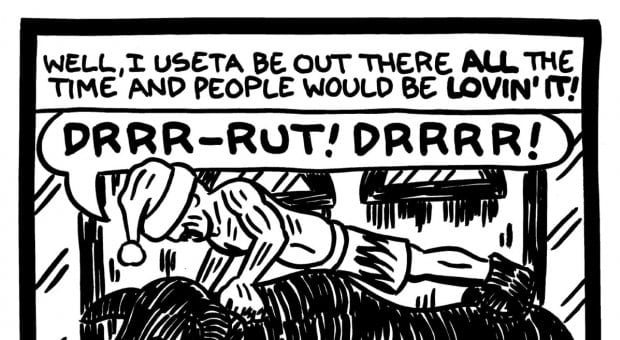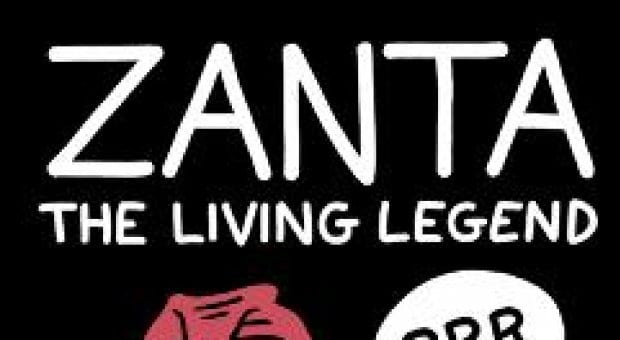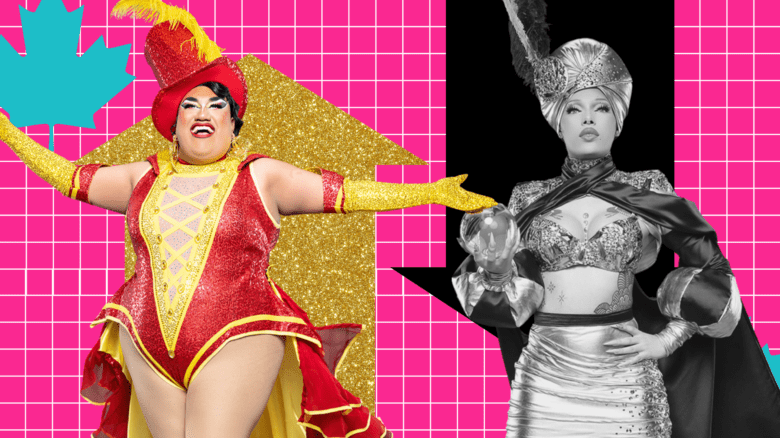Jason Kieffer’s graphic novel Zanta: The Living Legend begins with images that will be familiar to many Torontonians who remember Zanta.
“Merry Christmess [sic]!” screams Zanta. Or —“Drrrrr, Yes! Yes! Yes!”
Do you remember David Zancai – aka Zanta? You know, that guy who, no matter the weather, wore just boots, shorts and a Santa Claus hat and ran around doing knuckle pushups on the sidewalk.
No?
Bulging muscles – does that help?
If you still can’t remember, it’s probably because it’s been a few years since Zanta’s been around – Zancai was effectively banned from downtown and from using the TTC after police arrested him several times for disturbing the peace.
“That made me upset, angry, and was sort of my main drive for doing this story,” says Kieffer, whose book begins with a sketch documenting how Zancai developed the character Zanta.
After falling and seriously injuring his back in April 2000, Zancai began an intensive exercise routine to get back into shape. He was soon kicked out of his gym because he spent so much time flexing in the mirrors, so he began exercising on the street, telling jokes to people he met.
Around the same time, Zancai first wore the Santa Claus hat to a custody hearing to cheer up his young daughter. After the trial, he continued to wear the hat as a kind of reminder of his daughter. These factors, along with his sculpted naked upper body, combined to create Zanta — and to attract a lot of police attention.
Zancai was arrested repeatedly and spent some time in a mental health facility.
“The way I interpret his whole story is that it came from a place of chaos and mental turmoil, and he ended up shaping it into an act,” Kieffer says.
Kieffer’s illustrations are simple but vivid. His story never mocks Zancai, instead portraying him as unusual but well meaning.
Noticing the similarity between Zancai and Santa — and given that he was wearing a Santa hat all the time — Zancai combined the names to create Zanta. From about 2003 to 2006 he was everywhere: Speakers’ Corner, outside the City TV window during episodes of Breakfast Television, on an episode of Kenny vs Spenny, and he also had a huge online presence. He considered himself a very successful freak.
But eventually police banned Zancai from certain locations and events in downtown Toronto – such as the area surrounding City TV and the St Patrick’s Day Parade.
One of the few events at which he remained welcome was Pride. “He said that he was well liked in the [gay] community and would go to the Pride parade as Zancai and didn’t get kicked out,” Kieffer says.
In the book, Zancai explains his acceptance at Pride: “It’s probably cuz I’m not the only freak who’s there” – a compliment from a man who aimed to be the biggest and best of Toronto’s freaks.
Kieffer employs different methods to tell the succeeding episodes of Zancai’s life, from simple narrative to an extended radio conversation on a Toronto call-in show. These sections are vivid, if sometimes repetitive, and offer readers a new perspective on Zancai’s story.
Kieffer compares Zanta to a street performer in New York City known as the Naked Cowboy – a hot blond lad who carries a guitar wearing only cowboy boots, cowboy hat and briefs.
Yet because Zancai lives in Etobicoke and has been banned from using the TTC, downtown Toronto has lost its favourite freak.
“In New York they have the Naked Cowboy, and in Toronto we have Zanta.
“But no, we don’t anymore,” Kieffer laments.



 Why you can trust Xtra
Why you can trust Xtra


